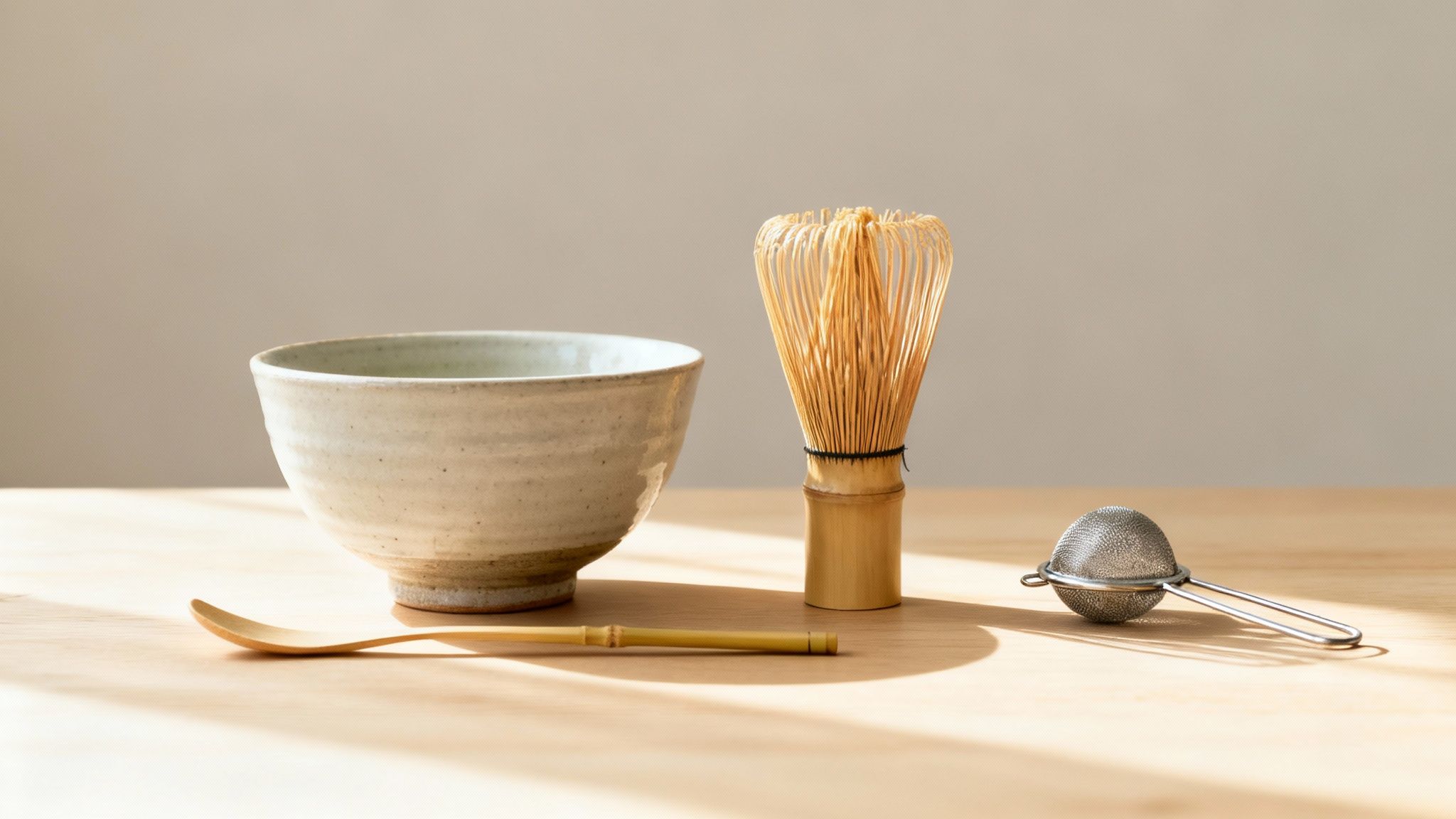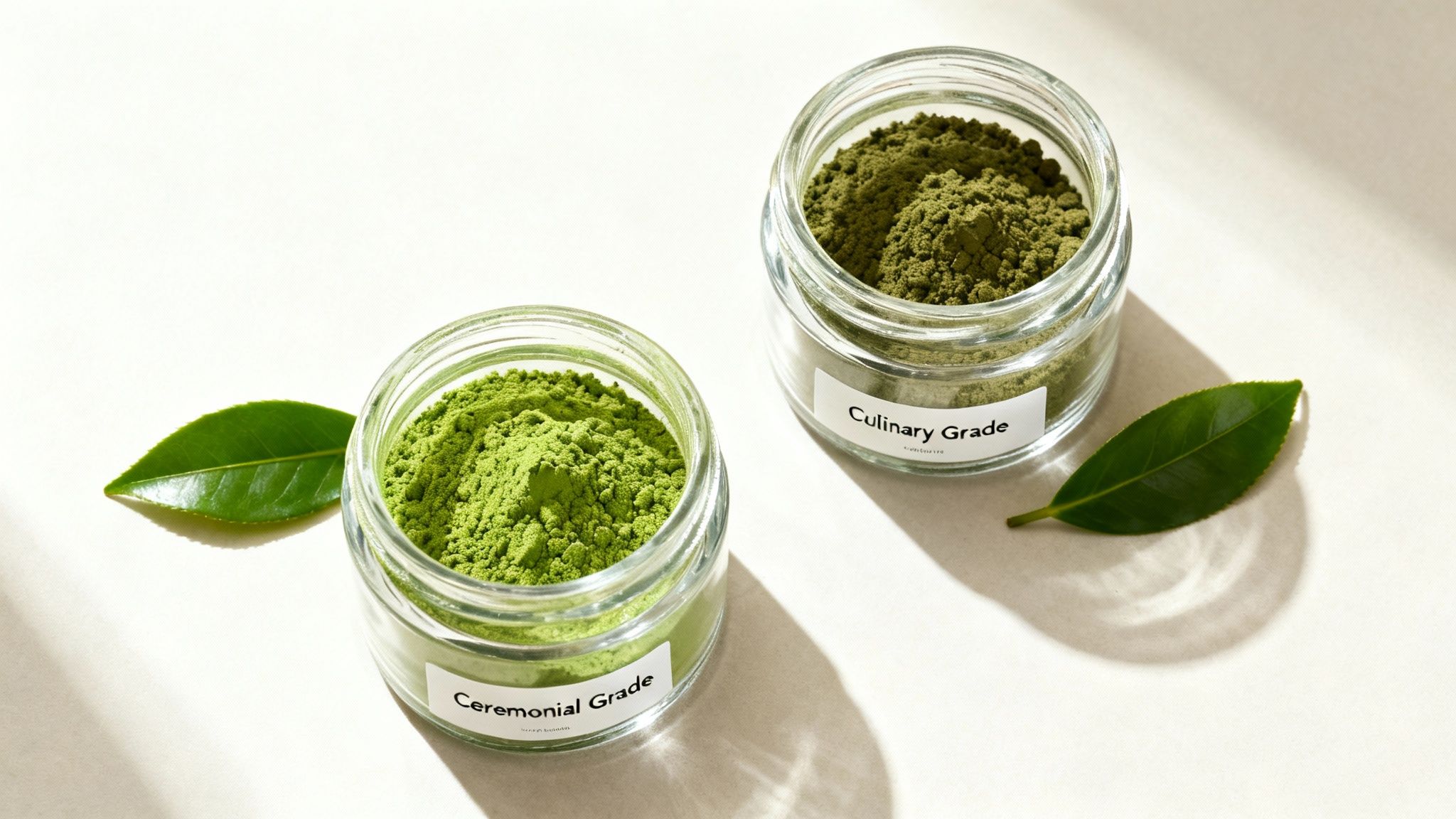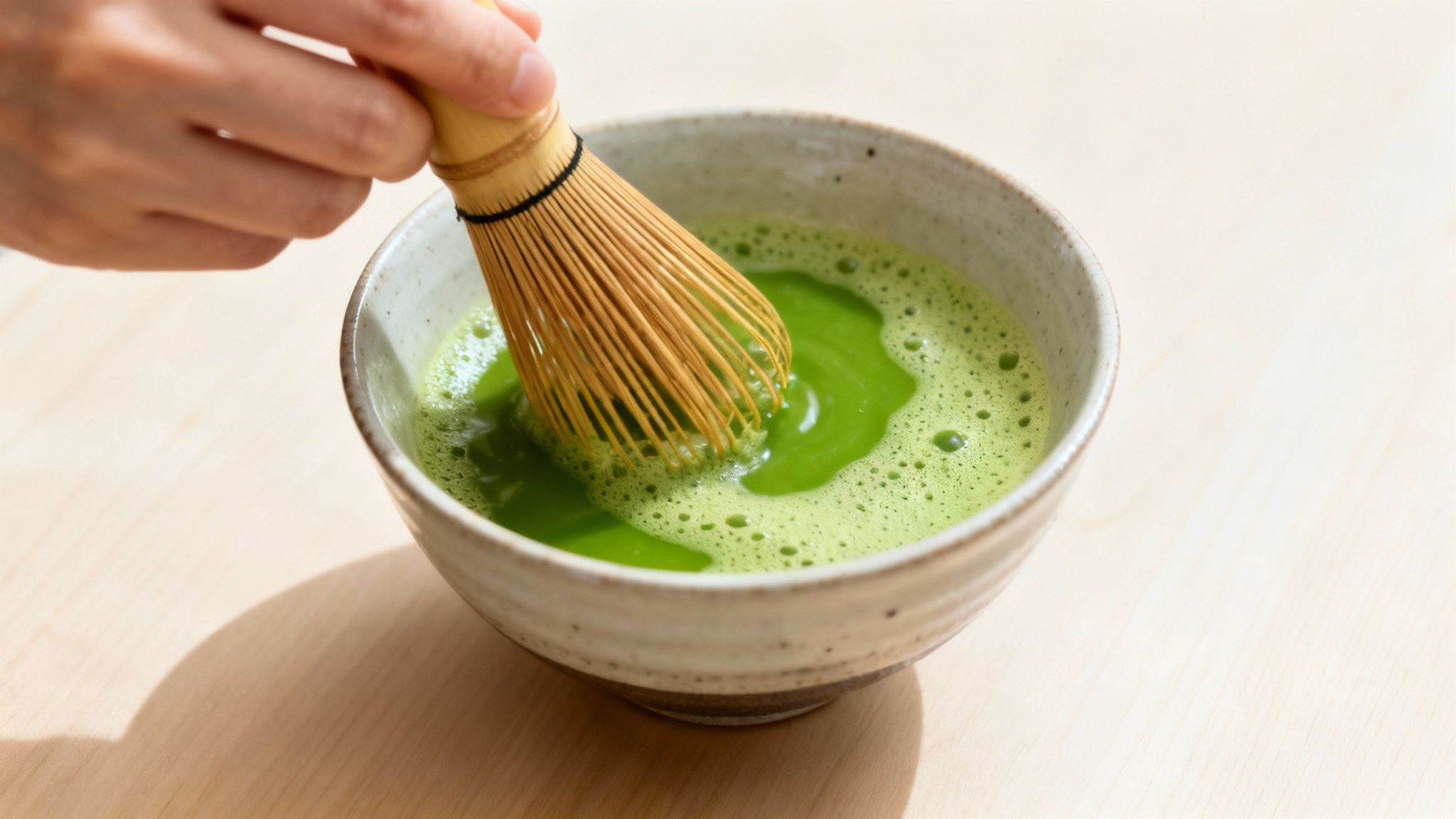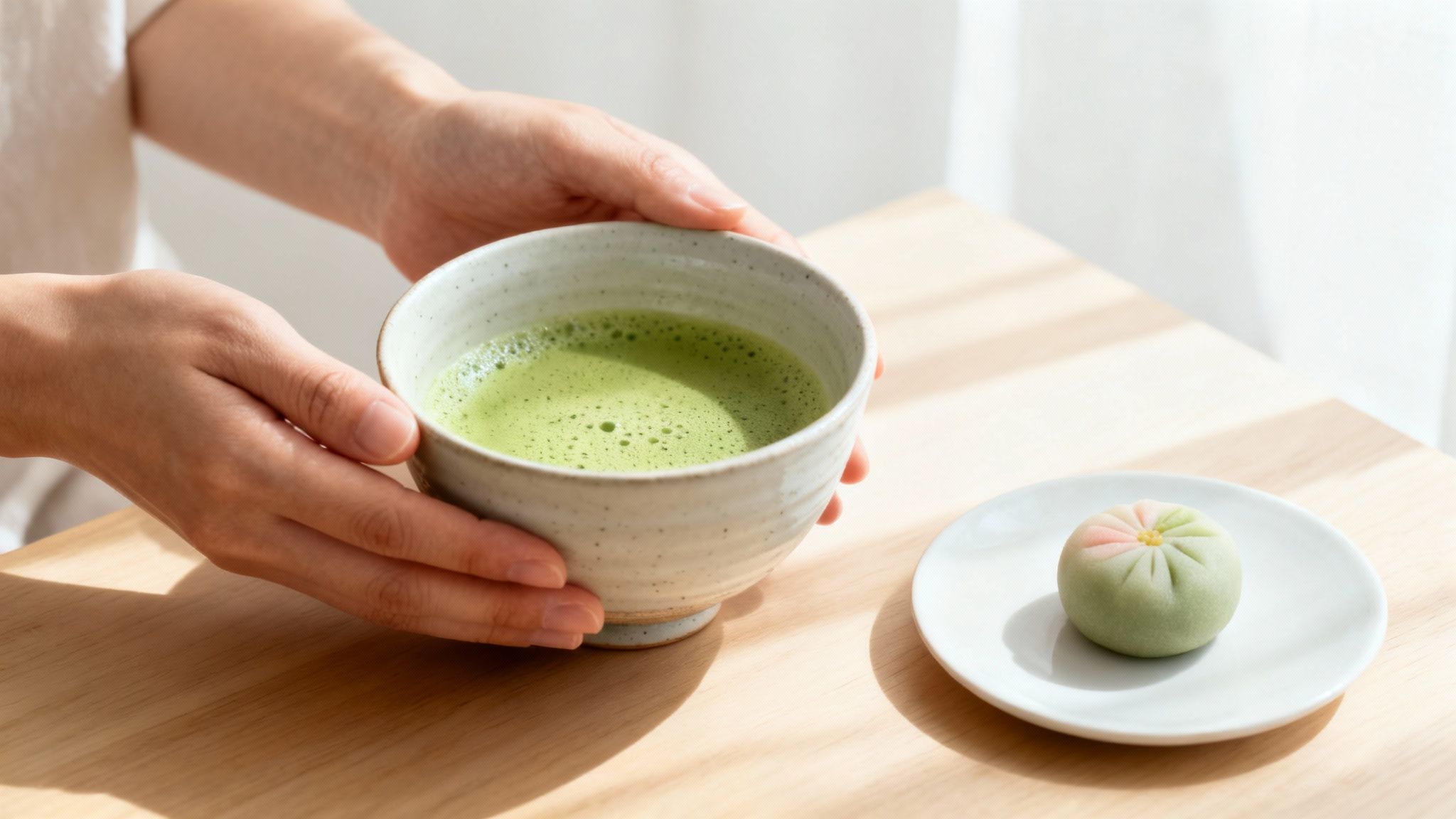Preparing matcha is more than just making a drink; it's a mindful ritual that transforms finely ground green tea leaves into a vibrant, frothy brew. It's a world away from simply steeping a tea bag. The process of whisking the powder with hot water means you’re consuming the entire leaf, unlocking its full, complex flavour and all its wellness benefits.
The Enduring Allure of Matcha Culture
Matcha has gracefully stepped beyond being a passing trend to become a cherished daily practice for so many of us. I think its real appeal lies in the deliberate, almost meditative process of its creation. Making matcha isn't about rushing; it's about carving out a moment of pause, a small ceremony that offers a welcome escape from the chaos of modern life. This mindful preparation is exactly what sets it apart from casually dropping a teabag into a mug.
This ritual fosters a much deeper connection to what you're about to enjoy. You get to fully engage with the brilliant green colour of the powder, the earthy aroma that fills the air, and the unique, rhythmic whisking motion. It’s a full sensory experience that results in a drink with a flavour profile you just can't get from standard green tea—a smooth, umami-rich taste with just a hint of natural sweetness.
From Ancient Tradition to Modern Wellness
The reasons behind matcha's booming popularity are a wonderful mix of ancient tradition and modern health-consciousness. It's been the centrepiece of Japanese tea ceremonies for centuries, so its cultural significance runs deep. Today, that tradition has been embraced by a global audience, all seeking its unique taste and its renowned benefits.
You can see this growing appreciation in the market trends. The UK matcha tea market alone, for example, was valued at around 127.5 million USD and is expected to climb to an incredible 518 million USD by 2035. That’s a clear sign it has firmly cemented its place in the wellness landscape.
I’ve always found that the act of preparing matcha is a form of meditation in itself. The focused whisking and patient preparation encourage a state of calm alertness, making it a perfect way to start the day with clarity, rather than a jittery caffeine jolt.
For those of us who appreciate a more holistic approach to self-care, the mindful ritual of matcha can be beautifully complemented by exploring other tools for personal wellness. This dedication to quality and origin is a core value we hold dear, and you can learn more by reading our own introduction to the Tea Masters Series.
Assembling Your Essential Matcha Toolkit
To really get into the ritual of preparing matcha, you’ll need a bit more than just the powder. Having the right tools isn't about being stuffy or overly traditional; it’s all about function. Each piece is perfectly designed to help you create that smooth, frothy texture that makes a great bowl of matcha so special. Think of it as setting the stage.

There are four key items you’ll want to get your hands on: the Chawan (bowl), Chasen (whisk), Chashaku (scoop), and a fine-mesh tea sifter. Each one plays a vital part in turning that fine green powder into a vibrant, beautiful drink. Trust me, investing in a decent set will make all the difference to your daily matcha practice.
Getting to Know Your Tools
Your Chawan, or tea bowl, is probably the most recognisable piece of the kit. Its wide, flat bottom isn't just for looks—it provides the perfect surface for whisking. A standard coffee mug is simply too narrow and deep, which stops you from getting the rapid "W" or "M" motion needed to aerate the tea properly. A good chawan gives your whisk room to breathe.
Next up is the Chasen, the bamboo whisk. This is the real star of the show. Carved from a single piece of bamboo, its delicate tines are designed to break up any clumps and whip air into the mixture, creating that signature creamy foam. You can find different options out there, but a quality bamboo chasen matcha whisk is absolutely essential for getting the right consistency.
Then there's the Chashaku, the elegant bamboo scoop used to measure out your matcha. Its curved shape helps you portion out just the right amount—usually one to two scoops for a standard bowl. Sure, you could use a teaspoon, but the chashaku adds to the ritual and its design helps you avoid spilling the precious powder.
Finally, a small, fine-mesh sifter is completely non-negotiable if you want clump-free matcha.
My number one tip for a flawlessly smooth drink? Sift the powder directly into your chawan before adding water. Static and humidity can make matcha clump together in the tin, and no amount of whisking will break those stubborn lumps down once they get wet.
When you understand how these tools work together, you're not just buying equipment; you're investing in a more authentic, enjoyable experience. Each piece has a job to do, and together they ensure your journey into preparing matcha is a delicious success, right from the very first sip.
How to Choose the Right Matcha Grade
Stepping into the world of matcha can feel a bit overwhelming at first, especially when you see words like "Ceremonial" and "Culinary" floating around. But here’s the thing: not all green powders are created equal.
Choosing the right grade is easily the most important step in making a bowl of matcha you’ll actually want to drink. It dictates everything—the colour, the texture, and most importantly, the flavour.

For the traditional tea experience we’re after here, you absolutely must use Ceremonial Grade matcha. This is the highest quality you can get, made from the youngest, most delicate tea leaves picked during the very first harvest. These special leaves are stone-ground into an incredibly fine, silky powder, which is what gives it that signature vibrant, almost electric green colour.
Culinary Grade, on the other hand, is made for mixing. Think lattes, smoothies, and baking. It comes from older leaves, which gives it a much stronger, slightly bitter flavour profile and a duller, more yellowish-green hue. While it’s perfect for cooking, it’s far too astringent to be enjoyed on its own with just hot water. If you want to go deeper on the nuances, you can explore the different types of matcha tea here.
To help you tell them apart at a glance, here’s a quick breakdown.
Matcha Grades at a Glance
| Attribute | Ceremonial Grade | Culinary Grade |
|---|---|---|
| Best For | Traditional tea (just with water) | Lattes, smoothies, baking, cooking |
| Colour | Vibrant, electric green | Duller, yellowish-green |
| Flavour | Smooth, delicate, naturally sweet, umami notes | Bold, robust, slightly bitter, more astringent |
| Texture | Ultra-fine, silky powder | Coarser powder |
| Harvest | First harvest (youngest leaves) | Second or later harvests (older, more mature leaves) |
| Price Point | Higher | Lower |
Ultimately, Ceremonial Grade is designed for savouring, while Culinary Grade is an ingredient. For a proper brew, always go for ceremonial.
What to Look for When Buying Ceremonial Matcha
When you're shopping for a high-quality matcha, a few key signs on the packaging will tell you if you've found the good stuff. A truly great ceremonial grade matcha will always tick these boxes:
- Vibrant Green Colour: The powder should be a brilliant, vivid green. A dull or brownish tint means it's either low-quality or old.
- Japanese Origin: The best matcha always comes from Japan. Look for regions like Uji, Nishio, and Fukuoka, which are famous for producing top-tier tea.
- Fine Texture: It should feel as soft and fine as cornflour. A gritty texture is a dead giveaway that it wasn't ground properly.
- Sweet, Grassy Aroma: When you open the tin, you should be hit with a fresh, slightly sweet, and vegetal scent.
Remember, quality comes at a price. If you see ceremonial grade matcha for sale at a surprisingly low price, it’s almost certainly a lower-quality product that will brew up bitter and disappointing.
It's also worth knowing that outside factors can sometimes affect what's available. A global matcha shortage, often caused by poor weather in Japan’s main tea-growing regions, has recently strained supply in the UK. This can make high-quality ceremonial matcha a bit harder to find and more expensive.
By keeping an eye on these quality indicators, you can confidently pick a matcha that will deliver a truly exceptional and authentic experience.
Mastering the Art of Whisking Matcha
This is where the magic really happens. We're moving beyond the prep work and getting hands-on, transforming that vibrant green powder into a luxurious, frothy drink. Think of this as your personal workshop for creating the perfect bowl of matcha, every single time.

The whole thing is a sequence of small, deliberate actions. From warming the bowl to that final, satisfying whisk, each detail plays a part in the final flavour and texture. Following these steps will give you the confidence to whip up a consistently delicious and beautifully prepared bowl of matcha.
Preparing Your Workspace and Tools
Before you even think about whisking, a little bit of prep goes a very long way.
First, grab your chawan (matcha bowl) and pour in some hot water. Gently swirl it around to warm up the ceramic, then tip the water out and give the bowl a proper dry with a clean cloth.
Warming the bowl is such a simple, yet crucial, step. A cold bowl will instantly drop the temperature of your matcha, which can dull its delicate flavours and stop a good froth from forming. This little bit of effort ensures your tea stays at the perfect temperature right from the first sip.
Next up, it’s time to get your chasen (whisk) ready. Just pop the tines into a separate bowl of warm water for a minute or so. This ‘blooms’ the bamboo, making the delicate prongs soft and flexible. Not only does this help them create a better foam, but it also stops them from snapping when you get to the vigorous whisking bit.
Sifting and Adding Water for a Smooth Brew
Now for the one step you absolutely cannot skip if you want to avoid a lumpy brew: sifting.
Place your fine-mesh sifter over your warm, dry chawan. Using your chashaku (bamboo scoop), measure out one to two scoops of ceremonial grade matcha – that's roughly 1-2 teaspoons or 2-4 grams – and sift it straight into the centre of the bowl.
This breaks up any tiny clumps that form because of static or humidity, guaranteeing a silky-smooth texture. Trust me, no amount of whisking can save lumpy, unsifted matcha.
With your beautifully sifted powder sitting pretty, it’s time for the water. The temperature here is absolutely critical. You want hot water, but definitely not boiling. The sweet spot is somewhere between 70°C and 80°C. Water that’s too hot will scald the delicate tea leaves, leaving you with a bitter, unpleasant taste. If you don't have a temperature-controlled kettle, no worries – just let boiled water cool down for a few minutes before pouring.
Gently pour about 60 ml (2 ounces) of the hot water over the matcha powder.
The Whisking Technique for Perfect Froth
Here we go – the moment of transformation. Hold the chawan firmly with one hand and grip the chasen with the other. The key is to keep your wrist loose and relaxed. You’re not trying to press the whisk against the bottom of the bowl; you want it to dance freely just above the surface.
Start whisking in a rapid ‘M’ or ‘W’ shaped motion. It’s all in the wrist – a quick back-and-forth flick for about 15-20 seconds. Don't stir in circles; you're trying to whip air into the mixture. This zigzag pattern is what creates that beautiful, creamy layer of foam on top, known as the kama.
As you whisk, you'll see tiny bubbles start to form and multiply. Your goal is a uniform layer of microfoam, a bit like the crema you get on a good espresso. Once the surface is covered in a thick, frothy layer and you don’t see any large bubbles, your matcha is ready.
To finish, lift the chasen slowly from the centre of the bowl, creating a final, gentle peak in the foam. The whole process, from sifting to serving, is a mindful ritual that rewards you with a truly exceptional cup. By paying close attention to these details—the warm bowl, the sifted powder, the right water temperature, and that energetic whisking motion—you’ll absolutely master the art of preparing matcha.
How to Properly Taste and Serve Your Matcha
You've done the hard work, whisking away until a perfect, frothy bowl of vibrant green matcha is sitting in front of you. But the experience is far from over—in fact, it's just getting started. Learning how to properly taste and serve your matcha is what turns a simple drink into a mindful, restorative ritual.

Before you even think about taking a sip, just pause for a moment. Look at that gorgeous, spring-green colour. Appreciate the delicate layer of foam you created. This small moment of observation is a nod to the craft and tradition behind what's in your bowl.
The Art of Tasting
Right, let's take that first sip. Don't just knock it back; let the tea gently coat your tongue and the roof of your mouth. A really well-made bowl of ceremonial grade matcha is a journey of flavour.
First, you should get that profound umami richness—it's that satisfying, savoury quality that makes matcha so distinct. This should then give way to a subtle, natural sweetness and a smooth, almost creamy texture. What you don't want is any harsh bitterness. If it's bitter, it's a sure sign your water was a touch too hot. The finish should be clean and refreshing, with just a hint of those lovely vegetal notes lingering.
Want the full, traditional experience? Cradle the chawan (tea bowl) with both hands. Rest it in the palm of your left hand and use your right hand to gently support the side. It's a gesture of respect, and it also allows you to connect with the warmth of the tea.
Holding the bowl this way forces you to slow down, encouraging you to truly savour every part of the drink—from its temperature to its delicate aroma.
Perfect Pairings and Modern Servings
In a traditional Japanese tea ceremony, matcha is almost always served with a small, sweet treat called wagashi. These are often little works of art, meticulously designed to complement the earthy notes of the tea. That touch of sweetness is the perfect counterpoint to matcha’s rich umami, creating a beautiful balance.
You don't need to track down authentic wagashi to get the same effect at home, though. A simple biscuit, a small piece of mochi, or even a square of good dark chocolate will do the trick nicely.
It’s no secret that matcha has exploded in popularity, and you can see its influence all over UK café culture. Its premium status has definitely had an impact on what we're willing to spend. In Edinburgh, for example, some iced matcha lattes have been seen costing nearly £6. It just goes to show the high demand, especially among younger crowds. If you're curious, you can read more about this trend and how a Japanese heatwave impacted UK matcha prices.
Your Matcha Questions, Answered
Even with the best instructions, a few questions always pop up when you're getting the hang of something new. Making a proper bowl of matcha is a lovely ritual, but a few common hurdles can catch you out at the beginning. Don’t worry, though—the fixes are usually surprisingly simple.
Let’s run through some of the most frequent queries that come up on the path to the perfect brew.
Why Is My Matcha Lumpy?
This is, without a doubt, the most common issue people face. The answer is beautifully straightforward: you have to sift it. Matcha powder is so incredibly fine that it loves to clump together, thanks to a bit of static and humidity. Once those little green nuggets get wet, no amount of frantic whisking will break them down.
The solution? Always pass your matcha through a fine-mesh sieve directly into your bowl before adding a drop of water. It's a tiny step that makes all the difference, guaranteeing a silky-smooth tea every single time. It's a non-negotiable part of the process for a reason.
Why Does My Matcha Taste So Bitter?
A bitter, harsh taste is the classic sign of one thing: your water was far too hot. Boiling water literally scorches the delicate tea powder, destroying all those complex, sweet, and umami notes you’re supposed to be tasting.
The sweet spot for water temperature is right around 80°C (175°F). If you don't have a variable-temperature kettle, just boil the water and let it sit for a few minutes to cool down before you pour it. Trust me, this small bit of patience is a game-changer.
Of course, the quality of your matcha plays a huge role here, too. A lower-quality or culinary-grade powder will naturally have a more astringent, bitter flavour. For drinking straight, you really want to be using a good Ceremonial Grade.
How Do I Get That Beautiful Froth?
Ah, the kama—that signature creamy foam. Getting it right is all about your tools and your technique. If your matcha is looking a bit flat, let's troubleshoot.
- Check your whisking motion. The most common mistake is stirring in circles. What you need is a rapid, zigzag motion, like you’re drawing a 'W' or an 'M' over and over in the bowl. It's that quick agitation that whips air into the liquid.
- Look at your whisk. Is your bamboo chasen in good shape? You should always soak the tines in warm water for a moment before each use. This makes them soft and pliable, which not only helps create a better foam but also prevents them from snapping.
- Consider your bowl. A proper matcha bowl, or chawan, has a wide, flat bottom for a reason—it gives you the room you need to whisk properly. Trying to do it in a narrow coffee mug just won't work.
As you explore healthy drinks, you might find that other teas can also support your wellness goals. For anyone interested, there's a fantastic guide on teas that can help curb sugar cravings, which could be a lovely addition to your new matcha ritual.
Ready to create your own perfect bowl? Explore our curated collection of authentic Ceremonial Grade matcha and handcrafted tea tools at Jeeves & Jericho. Find everything you need to begin your journey at https://www.jeevesandjericho.com.


